One to One Functions - Graph, Examples | Horizontal Line Test
What is a One to One Function?
A one-to-one function is a mathematical function whereby each input correlates to just one output. That is to say, for each x, there is a single y and vice versa. This implies that the graph of a one-to-one function will never intersect.
The input value in a one-to-one function is the domain of the function, and the output value is known as the range of the function.
Let's look at the images below:
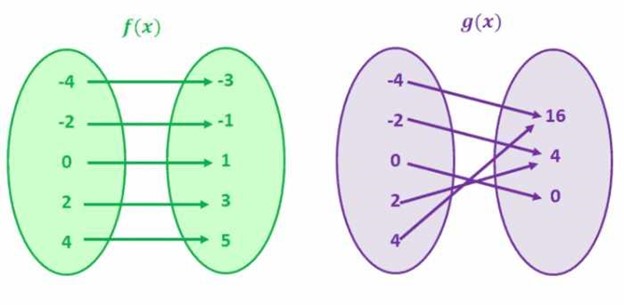
For f(x), each value in the left circle correlates to a unique value in the right circle. In conjunction, each value in the right circle corresponds to a unique value on the left. In mathematical words, this implies every domain has a unique range, and every range owns a unique domain. Therefore, this is an example of a one-to-one function.
Here are some additional representations of one-to-one functions:
-
f(x) = x + 1
-
f(x) = 2x
Now let's examine the second picture, which displays the values for g(x).
Notice that the inputs in the left circle (domain) do not own unique outputs in the right circle (range). Case in point, the inputs -2 and 2 have the same output, that is, 4. In the same manner, the inputs -4 and 4 have equal output, i.e., 16. We can discern that there are equivalent Y values for multiple X values. Hence, this is not a one-to-one function.
Here are some other representations of non one-to-one functions:
-
f(x) = x^2
-
f(x)=(x+2)^2
What are the qualities of One to One Functions?
One-to-one functions have the following properties:
-
The function holds an inverse.
-
The graph of the function is a line that does not intersect itself.
-
It passes the horizontal line test.
-
The graph of a function and its inverse are the same concerning the line y = x.
How to Graph a One to One Function
To graph a one-to-one function, you will need to find the domain and range for the function. Let's look at a straight-forward representation of a function f(x) = x + 1.
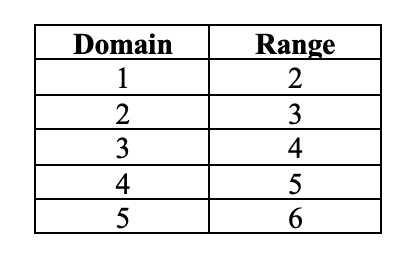
Once you possess the domain and the range for the function, you ought to plot the domain values on the X-axis and range values on the Y-axis.
How can you determine whether a Function is One to One?
To indicate if a function is one-to-one, we can apply the horizontal line test. Immediately after you chart the graph of a function, draw horizontal lines over the graph. In the event that a horizontal line intersects the graph of the function at more than one spot, then the function is not one-to-one.
Since the graph of every linear function is a straight line, and a horizontal line doesn’t intersect the graph at more than one place, we can also reason that all linear functions are one-to-one functions. Remember that we do not leverage the vertical line test for one-to-one functions.
Let's examine the graph for f(x) = x + 1. As soon as you plot the values to x-coordinates and y-coordinates, you have to review whether or not a horizontal line intersects the graph at more than one place. In this instance, the graph does not intersect any horizontal line more than once. This indicates that the function is a one-to-one function.
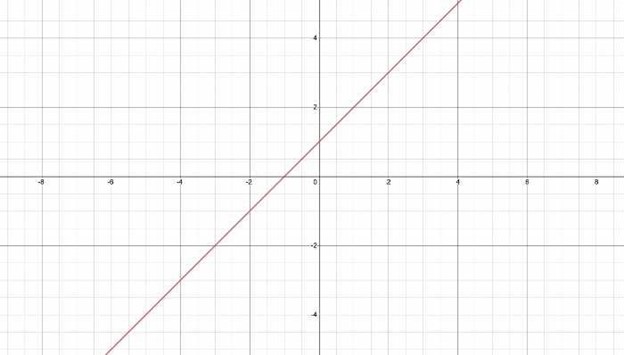
Subsequently, if the function is not a one-to-one function, it will intersect the same horizontal line more than once. Let's examine the graph for the f(y) = y^2. Here are the domain and the range values for the function:
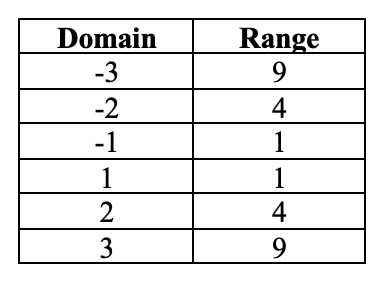
Here is the graph for the function:

In this example, the graph crosses multiple horizontal lines. For example, for each domains -1 and 1, the range is 1. In the same manner, for each -2 and 2, the range is 4. This means that f(x) = x^2 is not a one-to-one function.
What is the opposite of a One-to-One Function?
Considering the fact that a one-to-one function has just one input value for each output value, the inverse of a one-to-one function is also a one-to-one function. The inverse of the function basically undoes the function.
Case in point, in the case of f(x) = x + 1, we add 1 to each value of x in order to get the output, or y. The inverse of this function will subtract 1 from each value of y.
The inverse of the function is denoted as f−1.
What are the properties of the inverse of a One to One Function?
The characteristics of an inverse one-to-one function are no different than all other one-to-one functions. This signifies that the reverse of a one-to-one function will have one domain for every range and pass the horizontal line test.
How do you find the inverse of a One-to-One Function?
Figuring out the inverse of a function is not difficult. You just need to change the x and y values. For example, the inverse of the function f(x) = x + 5 is f-1(x) = x - 5.
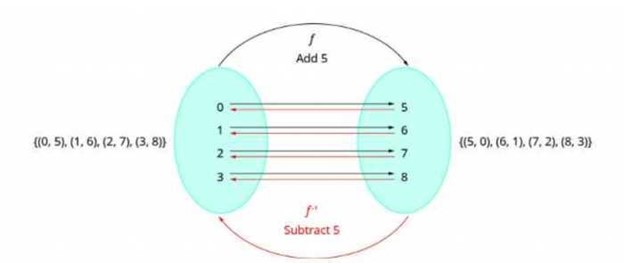
As we reviewed earlier, the inverse of a one-to-one function reverses the function. Considering the original output value showed us we needed to add 5 to each input value, the new output value will require us to deduct 5 from each input value.
One to One Function Practice Examples
Contemplate the following functions:
-
f(x) = x + 1
-
f(x) = 2x
-
f(x) = x2
-
f(x) = 3x - 2
-
f(x) = |x|
-
g(x) = 2x + 1
-
h(x) = x/2 - 1
-
j(x) = √x
-
k(x) = (x + 2)/(x - 2)
-
l(x) = 3√x
-
m(x) = 5 - x
For any of these functions:
1. Determine if the function is one-to-one.
2. Graph the function and its inverse.
3. Figure out the inverse of the function numerically.
4. Specify the domain and range of every function and its inverse.
5. Use the inverse to determine the value for x in each formula.
Grade Potential Can Help You Learn You Functions
If you find yourself facing difficulties using one-to-one functions or similar topics, Grade Potential can connect you with a one on one tutor who can support you. Our Arlington math tutors are experienced professionals who assist students just like you improve their mastery of these subjects.
With Grade Potential, you can work at your individual pace from the comfort of your own home. Schedule an appointment with Grade Potential today by calling (571) 497-4759 to get informed about our tutoring services. One of our representatives will get in touch with you to better ask about your needs to set you up with the best instructor for you!




